LG 50PS8000 50in Plasma TV Review
LG 50PS8000 50in Plasma TV
If you're after a well-priced 50in plasma TV, LG's 50PS8000 is certainly worth a look.
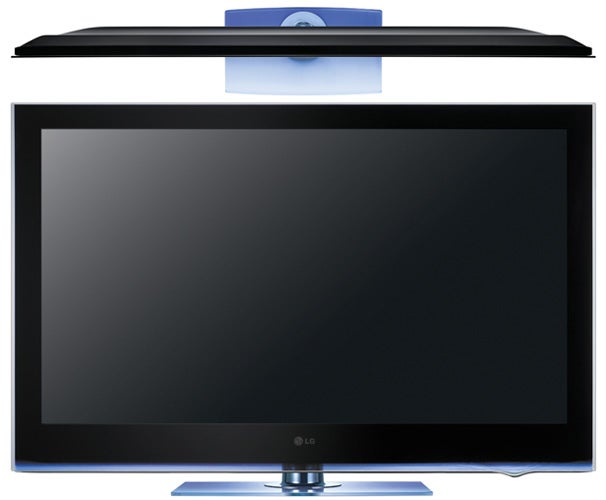
Verdict
Key Specifications
- Review Price: £1200.00
One of the hottest topics of conversation in the AV world these days is the prospect of rising prices brought about by the plummeting value of the pound. Apparently, though, nobody has thought to tell LG about this situation. For hot on the heels of its decently affordable 42LF7700 Freesat TV last week, the Korean brand has raised our eyebrows even higher with the 50PS8000: a 50in plasma TV going for just £1,200.
What’s more, this is no stripped down, basics-only model. For starters, it actually steals a march over upcoming Panasonic TVs by being the first TV to claim 600Hz processing. Given that Sony has only recently delivered 200Hz processing to the accompaniment of much fanfare, getting 600Hz on the 50PS8000 seems like a pretty remarkable feat. So how’s it done?
Keeping things as simple as possible, the 600Hz figure is arrived at by introducing to the frame-counting ‘equation’ plasma’s Sub-field driving specification. In other words, for every second of footage the 50PS8000 delivers the 50fps demanded by the PAL video standard multiplied by 12 extra sub-fields/frames added by the TV’s processors. Fifty x 12 being, of course, 600Hz.
Given that many plasma brands have long been adding extra frames of video information to their pictures, the 50PS8000’s 600Hz claim could be described merely as a new numbers game used to undermine Sony’s 200Hz successes. But I guess this doesn’t really matter if putting a number on things makes things easier for end buyers to understand.
Another ‘premium’ thing about the ultra-affordable 50PS8000 is its design. For it’s one of LG’s ‘single-layer’ jobs, where the screen and its bezel present one totally smooth face to the world, rather than the screen being recessed back from the bezel as is usually the case.
There’s some interesting stuff going on with the 50PS8000’s connections, too. Four HDMIs will win it fans among the serious AV community, while a DivX-capable USB port and some Bluetooth wireless connectivity are on hand for portable gadget hounds.
This latter feature allows the TV to be used with a Bluetooth headset, or for receiving photos and music via a suitable Bluetooth external device – most likely a mobile phone.
Old fart that I am, I’m still not entirely convinced that these Bluetooth shenanigans are really all that worthwhile. But hey – it’s not as if LG seems to be making you pay for them, so I guess they can be seen as just a handy bonus rather than a key feature that makes or breaks the TV.
Of far more ‘serious’ interest is the 50PS8000’s THX certification. This means the TV has been ‘approved’ for picture quality by George Lucas’ THX group, pretty much the AV world’s only worldwide independent quality assurance system.
In the 50PS8000’s case, this THX approval gains its fullest expression in the inclusion among the TV’s picture presets of a THX movie mode, delivering the picture setting THX recommends you use to watch films. But also key to the 50PS8000 finding official favour with THX – and the Imaging Science Foundation, with it professional calibration service – is doubtless its truly extreme image flexibility.
Under not one, but two user-definable ‘Expert’ memory slots you can fine-tune just about every aspect of the image. Running through everything on offer would take hundreds of words and no doubt bore you to death, but there are definitely one or two things I just have to mention. 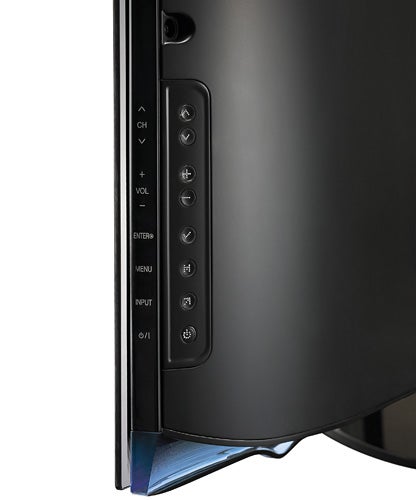
You can, for instance, turn on or off the set’s Dynamic Contrast feature, where elements of the picture – including the backlight – are adjusted in response to the content of the source image, mostly with a view to boosting black levels during dark scenes without compromising vibrancy during bright scenes.
There’s also a Black Level booster, edge enhancement circuitry, a Colour filter, and a startlingly sophisticated colour management system that allows you to adjust the contrast and brightness of the red, green and blue colour elements, as well as the tint and general colour properties of the red, green, blue, magenta, cyan and yellow colour elements.
As if all this wasn’t impressive enough on such an affordable TV, the set even provides a few (admittedly basic) test patterns to help you optimise contrast, brightness, sharpness, colour and white balance. Excellent stuff.
We’re nearly through with all the 50PS8000’s features at last, you’ll be pleased to know. All that’s left to say is that it’s a Full HD screen, with a vast claimed contrast ratio of 2,000,000:1, a high claimed maximum brightness of 1,500cd/m2, and a startling hint of blue in its appealing design.
Turning finally to the 50PS8000’s picture quality, it’s both slightly disappointing and pretty impressive all at the same time. Disappointing in that it doesn’t quite live up to all the TV’s specification, yet impressive in that it’s at times very good for the TV’s price.
Let’s get the good news sorted first. Kicking off with the picture’s impressive brightness, which lets pictures explode off the screen in a way you certainly don’t get with Panasonic’s recently reviewed new (admittedly low-end) P37X10 plasma TV.
Also an attraction, as expected, is the sheer extent to which you can adjust the 50PS8000’s picture quality. It really is possible to make pictures look like they’re coming from two, three, four or even five completely different TVs by careful tweakage of the endless options available. And although arriving at your preferred settings might take a while, there’s a good chance that at least one of the 50PS8000’s picture identities will please you.
The set also boasts some well-saturated and vigorous colours, which add further to the sense of dynamism the picture builds. As do the TV’s black levels, which get deep enough to provide a suitably profound counterpoint to the screen’s rich colours. 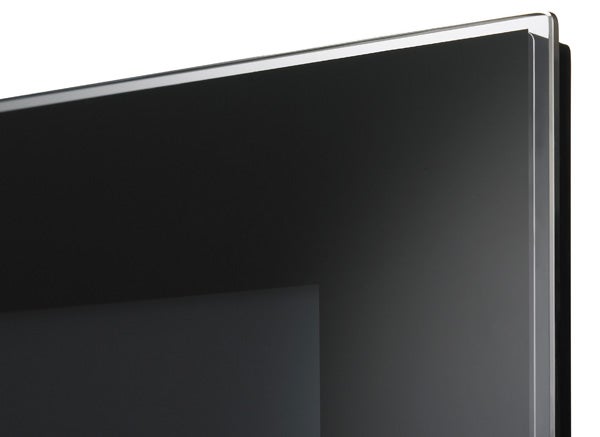
For the most part the THX picture preset is a notable success, too. Some may find its colour temperature a touch warm for their tastes, but it actually seems to sit pretty closely to the D65 video standard.
HD images, meanwhile, are also impressively sharp. Not as aggressively so as with the best high-end plasma or LCDs, perhaps, but enough to do justice to HD without having to look gritty, noisy or forced.
Finally in the plus column, the 50PS8000’s ‘600Hz’ operation does its work without generating serious processing side effects. Occasionally there’s a small shimmering effect around the edges of particularly fast-moving objects, but this is sufficiently rare and low-level that I personally didn’t have a major issue with it.
Kicking off the things I DO have an issue with, though, is image retention. A once common problem with plasma technology, LG now seems to be the only big plasma brand that really struggles with this issue. For instance, as the bright white Sony and blue Blu-ray logos that make up my Blu-ray player’s ‘screen saver’ disappeared from the screen as a disc started to play, both logos remained visible as shadowy ghosts for some seconds over the dark images that opened the disc.
I haven’t seen evidence to suggest that this retention issue could easily give rise to permanent screen burn, and LG has provided three techniques for reducing the problem: White and colour washes, and an orbiter that shifts the picture around slightly. But I’d certainly suggest extreme caution about exposing the screen to bright logos or static video game graphics over extended periods, especially in the TV’s first 100 hours or so of use.
Another issue is that while better than those of most LCD TVs, the 50PS8000’s black levels aren’t as profound as the best we’ve seen from Panasonic, Samsung and, of course, Pioneer. There’s definitely a slight grey-green undercast to the blackness of a night sky or dark suit that you don’t get with the best plasma offerings.
Next, while the 600Hz operation doesn’t generate many nasty side effects, nor does it have a particularly positive impact on picture quality. Maybe there’s a little less blur around than you’d normally see, but the picture still judders a touch when watching films – or, at least, 1080p/24 Blu-ray films.
To be fair, the impact of this judder is much less pronounced than it is on, say, the cheap 37in Panasonic plasma we tested last week. And in fact I suspect some, possibly many, cinephiles will prefer the slightly film-like stutter visible with films to complete and utter fluidity. But if you were expecting a number as high as 600 to at least deliver the option of complete fluidity, you’re out of luck.
Next, no matter what picture preset mode I used (even the THX one), I occasionally felt as if pictures had a tiny orange or green undertone to them.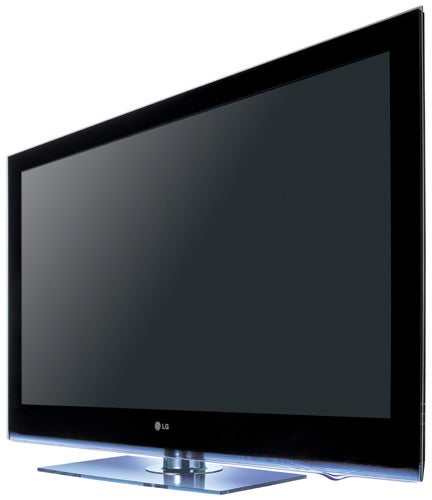
Finally, I have to say that the 50PS8000 really isn’t a very hot standard definition performer at all. The slight colour issues mentioned earlier occur more often, especially where skin tones are concerned. Standard def skin also tends to look very plasticky thanks to a lack of sharpness, detailing and colour nuancing. And finally pictures generally look rather soft, even with the noise reduction processing only set to low. You can try and improve things using the TV’s edge enhancement and sharpness tools, but both of these really just make the picture look more inconsistent and noisy – especially the edge enhancement system, which generally creates a nasty glowing halo effect around any edge it sharpens.
The 50PS8000’s sound comes courtesy of LG’s Invisible Speaker system, where the TV’s whole bezel effectively acts as a speaker. And with plenty of bezel to work with, the system works very well. Trebles are particularly well handled, with effects being propelled beyond the screen’s boundaries with accuracy and without harshness. The mid-range also sounds attractively open and powerful, ensuring that even action movie scenes don’t sound cramped. Bass is the set’s ‘weakest link’ sonically speaking, but while no great depths of bass are achieved, what there is sounds punchy enough to add drama without overwhelming the mid-range.
”’Verdict”’
How much you like the 50PS8000 is directly connected to how much money you’ve got to spend and how much HD you’ve got to watch. If you’re feeling the pinch, getting 50in of bright, colourful, good-with-HD pictures, a nice design and bags of connections and features for £1,200 probably sounds too good to be true. However, even the 50PS8000’s reams of features can’t make its pictures as good overall as those found on the best Samsung, Pioneer and Panasonic plasmas, especially if you spend most of your time watching standard definition.
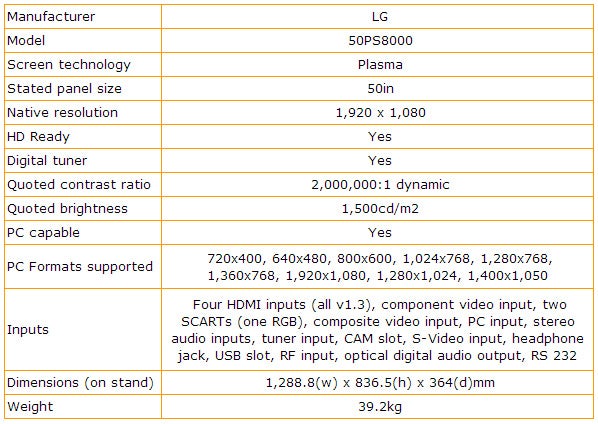
How we test televisions
We test every TV we review thoroughly over an extended period of time. We use industry standard tests to compare features properly. We’ll always tell you what we find. We never, ever, accept money to review a product.
Trusted Score
Score in detail
-
Features 9
-
Value 9
-
Image Quality 7
-
Design 8
-
Sound Quality 8
Features
| Size (Inch) | 50in |
| Display Type | Plasma |

